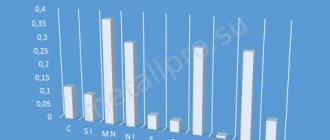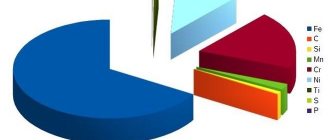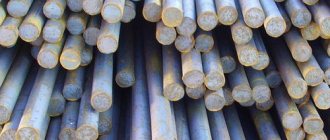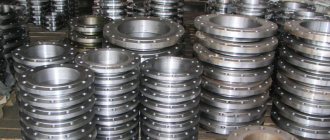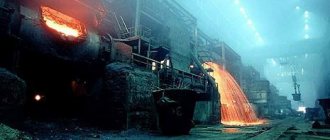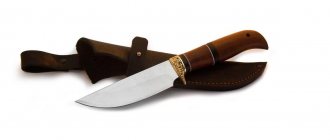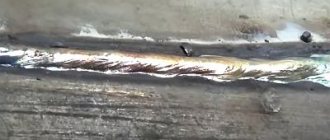Any specialist who deals with metal is familiar with the concept of “steel grade”. Deciphering the markings of steel alloys makes it possible to get an idea of their chemical composition and physical characteristics. Understanding this marking, despite its apparent complexity, is quite simple - it is only important to know on what principle it is compiled.
Rarely does production operate without steel, so understanding its grades is extremely important
The alloy is designated by letters and numbers, which can be used to accurately determine which chemical elements it contains and in what quantity. Knowing this, as well as how each of these elements can affect the finished alloy, it is possible to determine with a high degree of probability exactly what technical characteristics are characteristic of a particular grade of steel.
Types of steels and features of their markings
Steel is an alloy of iron and carbon, the content of which is no more than 2.14%. Carbon gives the alloy hardness, but if it is in excess, the metal becomes too brittle.
One of the most important parameters by which steels are divided into different classes is the chemical composition. Among the steels according to this criterion, alloyed and carbon steels are distinguished, the latter are divided into low-carbon (carbon up to 0.25%), medium-carbon (0.25–0.6%) and high-carbon (they contain more than 0.6% carbon).
By including alloying elements in the steel, it can be given the required characteristics. It is in this way that, by combining the type and quantitative content of additives, grades with improved mechanical properties, corrosion resistance, magnetic and electrical characteristics are obtained. Of course, it is possible to improve the characteristics of steels using heat treatment, but alloying additives make it possible to do this more efficiently.
Based on the quantitative composition of alloying elements, low-, medium- and high-alloy alloys are distinguished. In the first alloying elements there is no more than 2.5%, in medium alloyed elements - 2.5–10%, in highly alloyed ones - more than 10%.
Steels are classified according to their purpose. Thus, there are instrumental and structural types, grades distinguished by special physical properties. Tool types are used for the production of stamping, measuring, and cutting tools, structural ones - for the production of products used in construction and mechanical engineering. Alloys with special physical properties (also called precision) are used to make products that must have special characteristics (magnetic, strength, etc.).
Steels are also contrasted with each other based on their special chemical properties. Alloys of this group include stainless, scale-resistant, heat-resistant, etc. Typically, stainless steels can be corrosion-resistant and stainless steel for food - these are different categories.
In addition to useful elements, steel also contains harmful impurities, the main ones of which are sulfur and phosphorus. It also contains gases in an unbound state (oxygen and nitrogen), which negatively affects its characteristics.
If we consider the main harmful impurities, phosphorus increases the brittleness of the alloy, which is especially pronounced at low temperatures (the so-called cold brittleness), and sulfur causes cracks in metal heated to high temperatures (red brittleness). Phosphorus, among other things, significantly reduces the ductility of heated metal. Based on the quantitative content of these two elements, steels are divided into ordinary quality (no more than 0.06–0.07% sulfur and phosphorus), high-quality (up to 0.035%), high-quality (up to 0.025%) and especially high-quality (sulfur - up to 0.015%, phosphorus - up to 0.02%).
The marking of steels also indicates to what extent oxygen has been removed from their composition. According to the level of deoxidation, steels are divided into:
- calm type, designated by the letter combination “SP”;
- semi-calm - “PS”;
- boiling - “KP”.
What does the steel marking mean?
It has become quite easy to decipher the brand; you just need to have certain information. Structural steels of ordinary quality and not containing alloying elements are marked with the letter combination “St”. By the number following the letters in the name of the brand, you can determine how much carbon is in such an alloy (calculated in tenths of a percent). The numbers may be followed by the letters “KP”: from them it becomes clear that this alloy has not completely gone through the deoxidation process in the furnace, and accordingly, it belongs to the boiling category. If the brand name does not contain such letters, then the steel corresponds to the calm category.
Structural unalloyed steel, which belongs to the quality category, has two numbers in its designation; they are used to determine the average carbon content in it (calculated in hundredths of a percent).
Before we begin to consider the grades of those steels that include alloying additives, you should understand how these additives are designated. Marking of alloy steels may include the following letter designations:
Explanation of steel Х12Ф1
So, let's start with the simplest thing. Steel grade X12F1, according to all currently available GOSTs, is designated as die tool steel.
Having a general idea of the Russian steel naming system, taking into account the information already available, we can safely draw several conclusions:
- Steel is tool steel, which means it contains a certain set of alloying elements.
- The letter “X” at the beginning of the steel grade, as well as the number 12 after it, indicate a chromium content of 12%.
- The letter designation “F” corresponds to the alloying element vanadium, and the unit is the content in the region of 1%.
Designation of steels with alloying elements
As mentioned above, the classification of steels with alloying elements includes several categories. The marking of alloy steels is compiled according to certain rules, knowledge of which allows one to quite simply determine the category of a particular alloy and the main area of its application. In the initial part of the names of such brands there are numbers (two or one) indicating the carbon content. Two numbers indicate its average content in the alloy in hundredths of a percent, and one – in tenths. There are also steels that do not have numbers at the beginning of the brand name. This means that the carbon content in these alloys is within 1%.
The letters that can be seen behind the first digits of the brand name indicate what the alloy is made of. The letters that give information about a particular element in its composition may or may not be followed by numbers. If there is a number, then it determines (in whole percentages) the average content of the element indicated by the letter in the alloy, and if there is no number, it means that this element is contained in the range from 1 to 1.5%.
At the end of the marking of certain types of steel there may be the letter “A”. This suggests that this is high quality steel. These grades may include carbon steels and alloys with alloying additives in their composition. According to the classification, this category of steels includes those in which sulfur and phosphorus amount to no more than 0.03%.
Analogs
As you might guess, production processes at almost any enterprise producing the same product are approximately the same. And this does not depend in any way on the geographical location of production facilities. Accordingly, identical tools made from similar or analogous materials are used for similar work. Die steel X12F1 was no exception. In various countries, steel grades with a similar composition are produced just as successfully as in the post-Soviet space. Here are some of the most popular names:
- United States of America - D5;
- Japan - SKD11;
- England - BD2;
- Germany - X155CrVMo12-1.
By remembering these steel grades, even if you are far from your native land, you can be sure that you can easily find a part for yourself from the material you need.
Examples of marking steels of various types
Determining the grade of steel and assigning an alloy to a certain type is a task that should not cause any problems for a specialist. You don’t always have a table at hand that gives a breakdown of brand names, but the examples given below will help you figure it out.
Structural steels that do not contain alloying elements are designated by the letter combination “St”. The numbers following are the carbon content, calculated in hundredths of a percent. Low-alloy structural steels are marked somewhat differently. For example, 09G2S steel contains 0.09% carbon, and alloying additives (manganese, silicon, etc.) are contained within 2.5%. 10KhSND and 15KhSND, which are very similar in their markings, differ in different amounts of carbon, and the share of each alloying element in them is no more than 1%. That is why there are no numbers after the letters indicating each alloying element in such an alloy.
20Х, 30Х, 40Х, etc. – this is how structural alloy steels are marked; the predominant alloying element in them is chromium. The number at the beginning of such a mark is the carbon content in the alloy in question, calculated in hundredths of a percent. The letter designation of each alloying element can be followed by a number, which is used to determine its quantitative content in the alloy. If it is not there, then the specified element in the steel contains no more than 1.5%.
You can consider an example of the designation of chromium-silicon-manganese steel 30KhGSA. According to the labeling, it consists of carbon (0.3%), manganese, silicon, and chromium. It contains 0.8–1.1% of each of these elements.
Marking of steels according to American and European systems
Cold rolled sheet GOST 16523, 19904
You can read what types of reinforcement and reinforcing products there are in our article. Decorative concrete is one of the most popular finishing materials for personal plots. We wrote about how to make decorative stamped concrete with your own hands. Are you planning to buy rolled metal? Our store has reasonable prices and manufacturer's quality.
In the United States, there are several steel marking systems developed by various standards organizations. For stainless steels, the AISI system is most often used, which is also valid in Europe. According to AISI, steel is designated by three numbers, in some cases followed by one or more letters. The first number indicates the class of steel, if it is 2 or 3, then it is austenitic class, if 4 it is ferritic or martensitic. The next two digits indicate the serial number of the material in the group. The letters stand for:
- L – low mass fraction of carbon, less than 0.03%;
- S – normal concentration of C, less than 0.08%;
- N means nitrogen has been added;
- LN – low carbon content combined with nitrogen addition;
- F – increased concentration of phosphorus and sulfur;
- Se – steel contains selenium, B – silicon, Cu – copper.
In Europe, the EN system is used, which differs from the Russian one in that it first lists all alloying elements, and then, in the same order, their mass fraction is indicated in numbers.
The first number is the carbon concentration in hundredths of a percent. If alloy steels, structural and tool, except for high-speed steels, include more than 5% of at least one alloying additive, the letter “X” is placed in front of the carbon content.
EU countries use the EN marking, in some cases indicating in parallel the national mark, but with the mark “obsolete”.
How to decipher steel markings?
To make deciphering the designations of different types of steels easy, you should know well what they are. Certain categories of steel have special markings. They are usually designated by certain letters, which allows you to immediately understand both the purpose of the metal in question and its approximate composition. Let's look at some of these brands and understand their designation.
Structural steels specially intended for the manufacture of bearings can be recognized by the letter “Ш”; this letter is placed at the very beginning of their marking. After it in the brand name there is a letter designation of the corresponding alloying additives, as well as numbers by which the quantitative content of these additives is determined. Thus, steel grades ShKh4 and ShKh15, in addition to iron and carbon, contain chromium in amounts of 0.4 and 1.5%, respectively.
The letter “K”, which appears after the first digits in the brand name, indicating the quantitative carbon content, denotes structural non-alloy steels used for the production of vessels and steam boilers operating under high pressure (20K, 22K, etc.).
High-quality alloy steels, which have improved casting properties, can be recognized by the letter “L” at the very end of the marking (35ХМЛ, 40ХЛ, etc.).
Deciphering the grades of construction steel can cause some difficulty if you do not know the specifics of the markings. Alloys of this category are designated by the letter “C”, which is placed at the very beginning. The numbers following it indicate the minimum yield strength. These brands also use additional letter designations:
- letter T – heat-strengthened rolled products;
- letter K – steel, characterized by increased corrosion resistance;
- letter D is an alloy characterized by a high copper content (S345T, S390K, etc.).
Unalloyed steels belonging to the tool category are designated by the letter “U”; it is affixed at the beginning of their marking. The number following this letter expresses the quantitative carbon content in the alloy in question. Steels of this category can be high-quality and high-quality (they can be identified by the letter “A”, it is placed at the end of the brand name). Their marking may contain the letter “G”, which means a high content of manganese (U7, U8, U8A, U8GA, etc.).
Tool steels containing alloying elements in their composition are marked similarly to alloyed structural steels (KhVG, 9KhVG, etc.).
The marking of those steels that are included in the high-speed cutting category begins with the letter “P”, followed by numbers indicating the quantitative content of tungsten. Otherwise, brands of such alloys are named according to the standard principle: letters denoting the element, and, accordingly, numbers reflecting its quantitative content. The designation of such steels does not indicate chromium, since its standard content in them is about 4%, as well as carbon, the amount of which is proportional to the vanadium content. If the amount of vanadium exceeds 2.5%, then its letter designation and quantitative content are affixed at the very end of the marking (З9, Р18, Р6М5Ф3, etc.).
Unalloyed steels belonging to the electrical category are marked in a special way (they are also often called pure technical iron). The low electrical resistance of such metals is ensured due to the fact that their composition is characterized by a minimum carbon content - less than 0.04%. There are no letters in the designation of grades of such steels, only numbers: 10880, 20880, etc. The first digit indicates the classification by type of processing: hot-rolled or forged - 1, calibrated - 2. The second digit is associated with the category of the aging coefficient: 0 - non-standardized, 1 - normalized The third digit indicates the group to which this steel belongs according to the standardized characteristic taken as the main one. The value of the standardized characteristic itself is determined from the fourth and fifth digits.
The principles by which the designation of steel alloys is carried out were developed back in the Soviet period, but to this day they are successfully used not only in Russia, but also in the CIS countries. Having information about a particular grade of steel, you can not only determine its chemical composition, but also effectively select metals with the required characteristics.
Understanding this issue is important both for specialists who develop and design various metal structures, and for those who often work with various steels and manufacture parts from them for various purposes.
What can you learn from a brand?
For steel grade 30KhGSA, the decoding is as follows: high-quality (this is shown by “A” at the end of the grade), contains 0.3% carbon (which corresponds to the first digits), chromium, manganese and silicon - 1% each. Let's check whether the answer corresponds to the GOST 4543–71 standard for structural steels.
It's easy to learn everything about metal from state standards. Steel grades with interpretation in the table will show their full composition. The preamble indicates areas of application and other useful information.
It can be seen that for each steel grade, a table explaining the maximum content of a particular element will help to read the marking. In our case, carbon is in the range of 0.28-0.34; silicon 0.9-1.2; manganese 0.8-1.1; chromium 0.8-1.1.
It happens that you need metal of a similar grade. In this case, a comparative analysis of steel grades is carried out with a breakdown according to the table. For example, there is a melt of 30KhGSA steel with the following parameters: C=0.28; Si=1.0; Mn=0.9; Cr=1.1. Is it possible to mark metal 25KhGSA, if necessary? It is clear that the content of harmful impurities corresponds to the norm. The answer is clear: yes, the chemical composition fully corresponds to this brand. Thus, the same melt satisfies the conditions of two different grades.
Special characters
Additional letters are commonly used in some special purpose steels.
Let's list some of them:
- Unalloyed carbon tool ones (U7, U8, U10A, U8GA) contain a number after the letter “U”, it means a tenth of a percent of carbon.
- Bearing ones are immediately visible, they start with “Ш”: ШХ15, ШХ15СГ.
- Steels with improved casting properties are designated “L” at the end: 40ХЛ.
- Pressure vessel metal contains a "K" which indicates how much carbon is in the composition (20K).
- Marking of construction steels begins with “C” and can additionally use “K” - increased resistance to corrosion, “T” - heat-resistant rolled steel (C390K).
- High-speed tungsten-containing grades begin with “P”: R9K5, R18. The number after "P" indicates the tungsten content. If vanadium in them is more than 2.5%, then its content is indicated: P6M5F3 (3%). Chromium and carbon have standard values and are therefore not shown.
- It is worth mentioning the steels used for surfacing wire. They are designated at the beginning of the brand with the “NP” icon, for example, NP30ХGSA.
We can say that if any controversial issues regarding labeling arise, the answer can be found in the corresponding GOST or TU.
Structural steel with increased cutting machinability A12 - characteristics, properties, analogues
This page shows the technical, mechanical and other properties, as well as the characteristics of A12 steel.
Classification of material and application of grade A12
Grade: A12 Material classification: Structural steel with increased cutting machinability Additional information about the material: Carbon sulfur steel. According to GOST 1414-75, rolled steel A12 is not allowed for use in newly created and modernized equipment
Chemical composition of material A12 in percentage terms
| C | Si | Mn | S | P | Cu |
| 0.08 — 0.16 | 0.15 — 0.35 | 0.7 — 1.1 | 0.08 — 0.2 | 0.08 — 0.15 | up to 0.25 |
Mechanical properties of A12 at a temperature of 20 o C
| Assortment | Size | Eg. | sв | sT | d5 | y | KCU | Thermal change |
| — | mm | — | MPa | MPa | % | % | kJ/m2 | — |
| Hot rolled products, GOST 1414-75 | 410 | 22 | 34 | |||||
| The rental is calibrated. cold hardened, GOST 1414-75 | 460-510 | 7 |
Technological properties of A12
| Weldability: | not applicable to welded structures. |
| Flock Sensitivity: | sensitive. |
| Tendency to temper brittleness: | not inclined. |
Foreign analogs of A12
Explanation of symbols, abbreviations, parameters
Other brands in this category:
Please note that this information about the A12 brand is provided for informational purposes. The parameters, properties and composition of real A12 grade material may differ from the values given on this page. More detailed information about the A12 grade can be found on the information resource “Brand of Steel and Alloys”. You can check with our managers for information about the availability, delivery times and cost of materials. If you find inaccuracies in the description of materials or errors found, please inform the site administrators using the feedback form. Thanks in advance for your cooperation!
Steel A12 – State Enterprise Stalmash
Material characteristics steel A12
Chemical composition in % of material steel A12
Temperature of critical points of the material steel A12
| Ac1 = 735, Ac3(Acm) = 866, Ar3(Arcm) = 840, Ar1 = 685 |
Mechanical properties at T=20 o C material steel A12
| Assortment | Size | Eg. | sв | sT | d5 | y | KCU | Thermal change |
| — | mm | — | MPa | MPa | % | % | kJ/m2 | — |
| The steel is hot rolled. | 100 | 410 | 22 | 34 | Delivery status |
| The hardness of the material is hot-rolled steel A12, | HB 10 -1 = 160 MPa |
| The hardness of the material is steel A12, calibrated cold-worked, | HB 10 -1 = 217 MPa |
Physical properties of the material steel A12
| T | E 10 - 5 | a 10 6 | l | r | C | R 10 9 |
| hail | MPa | 1/Grad | W/(m deg) | kg/m 3 | J/(kg deg) | Ohm m |
| 20 | 1.98 | 7830 | ||||
| 100 | 1.83 | 11.9 | 78 | 470 | ||
| 200 | 12.5 | 67 | ||||
| 300 | 1.66 | 479 | ||||
| 400 | 13.6 | 517 | ||||
| 500 | 14.2 | |||||
| 600 | 571 | |||||
| T | E 10 - 5 | a 10 6 | l | r | C | R 10 9 |
Technological properties of the material steel A12
| Weldability: | not applicable to welded structures. |
| Flock Sensitivity: | sensitive. |
| Tendency to temper brittleness: | not inclined. |
Foreign analogues of the material A12 steel Attention! Both exact and closest analogues are indicated.
Designations:
| Mechanical properties : | |
| sв | — Short-term strength limit, [MPa] |
| sT | — Proportional limit (yield strength for permanent deformation), [MPa] |
| d5 | — Elongation at break, [%] |
| y | — Relative narrowing, [%] |
| KCU | — Impact strength, [kJ/m2] |
| HB | — Brinell hardness, [MPa] |
| Physical properties: | |
| T | — Temperature at which these properties were obtained, [Deg] |
| E | — Modulus of elasticity of the first kind, [MPa] |
| a | — Coefficient of thermal (linear) expansion (range 20 o - T), [1/degree] |
| l | — Thermal conductivity coefficient (heat capacity of the material), [W/(m deg)] |
| r | — Material density, [kg/m3] |
| C | — Specific heat capacity of the material (range 20 o — T), [J/(kg deg)] |
| R | — Electrical resistivity, [Ohm m] |
| Weldability: | |
| no limits | — welding is performed without heating and without subsequent heat treatment |
| limited weldability | — welding is possible when heated to 100-120 degrees. and subsequent heat treatment |
| difficult to weld | — to obtain high-quality welded joints, additional operations are required: heating to 200-300 degrees. during welding, heat treatment after welding - annealing |
Brand of steel and alloys
International analogues of corrosion-resistant and heat-resistant steels
Corrosion-resistant steels
| Europe (EN) | Germany (DIN) | USA (AISI) | Japan (JIS) | CIS (GOST) |
| 1.4000 | X6Cr13 | 410S | SUS 410 S | 08Х13 |
| 1.4006 | X12CrN13 | 410 | SUS 410 | 12Х13 |
| 1.4021 | X20Cr13 | (420) | SUS 420 J1 | 20Х13 |
| 1.4028 | X30Cr13 | (420) | SUS 420 J2 | 30Х13 |
| 1.4031 | X39Cr13 | SUS 420 J2 | 40Х13 | |
| 1.4034 | X46Cr13 | (420) | 40Х13 | |
| 1.4016 | X6Cr17 | 430 | SUS 430 | 12Х17 |
| 1.4510 | X3CrTi17 | 439 | SUS 430 LX | 08Х17Т |
| 1.4301 | X5CrNI18-10 | 304 | SUS 304 | 08Х18Н10 |
| 1.4303 | X4CrNi18-12 | (305) | SUS 305 | 12Х18Н12 |
| 1.4306 | X2CrNi19-11 | 304 L | SUS 304 L | 03Х18Н11 |
| 1.4541 | X6CrNiTi18-10 | 321 | SUS 321 | 08Х18Н10Т |
| 1.4571 | X6CrNiMoTi17-12-2 | 316 Ti | SUS 316 Ti | 10Х17Н13М2Т |
Heat-resistant steel grades
| Europe (EN) | Germany (DIN) | USA (AISI) | Japan (JIS) | CIS (GOST) |
| 1.4878 | X12CrNiTi18-9 | 321H | 12Х18Н10Т | |
| 1.4845 | X12CrNi25-21 | 310 S | 20Х23Н18 |
High speed steel grades
| steel grade | Analogues in US standards | ||
| CIS countries GOST | Euronorms | ||
| R0 M2 SF10-MP | — | — | A11 |
| R2 M9-MP | S2-9-2 | 1.3348 | M7 |
| R2 M10 K8-MP | S2-10-1-8 | 1.3247 | M42 |
| R6 M5-MP | S6-5-2 | 1.3343 | M2 |
| R6 M5 K5-MP | S6-5-2-5 | 1.3243 | — |
| R6 M5 F3-MP | S6-5-3 | 1.3344 | M3 |
| R6 M5 F4-MP | — | — | M4 |
| R6 M5 F3 K8-MP | — | — | M36 |
| R10 M4 F3 K10-MP | S10-4-3-10 | 1.3207 | — |
| R6 M5 F3 K9-MP | — | — | M48 |
| R12 M6 F5-MP | — | — | M61 |
| R12 F4 K5-MP | S12-1-4-5 | 1.3202 | — |
| R12 F5 K5-MP | — | — | T15 |
| R18-MP | — | — | T1 |
Steel circle 12xnza price in Moscow
Steel 12ХН3А - definition of steel grade, GOST, material characteristics
Steel grade - 12ХН3А
Standard - GOST 4543
Substitute - 12ХН2, 20ХН3А, 25ХГТ, 12Х2Н4А, 20ХНР
Steel 12ХН3А
contains an average of 0.12% carbon,
X
- indicates the chromium content in steel is approximately 1%,
H3
- indicates the nickel content in steel is about 3%, the letter
A
at the end of the brand means that the steel belongs to the high-quality category.
Steel 12ХН3А is used for the manufacture of large critical parts. Steel products are subjected to carburization followed by heat treatment; sometimes this steel is used for non-cemented parts. Steel with high strength, toughness and hardenability.
Gears, axles, shafts, worms, claw couplings, piston pins and other parts are made from steel 12ХН3А
| Mass fraction of basic chemical elements, % | ||||
| C - carbon | Si - silicon | Mn - manganese | Cr - chromium | Ni - nickel |
| 0,09-0,16 | 0,17-0,37 | 0,30-0,60 | 0,60-0,90 | 2,75-3,15 |
| Temperature of critical points, °C | |||
| Ac1 | Ac3 | Ar1 | Ar3 |
| 715 | 773 | 659 | 726 |
| Technological properties | |
| Forging | Forging temperature, °C: beginning 1220, end 800. Sections up to 100 mm are cooled in air, sections 101-300 mm are cooled in a pit. |
| Weldability | Limited weldability. Welding methods: manual arc welding, automatic arc welding, resistance welding. |
| Machinability | In the hot-rolled state at HB 183-187 and σв = 590 MPa: Kv hard alloy = 1.25 Kv high-speed steel = 0.95 |
| Flock sensitivity | Sensitive |
| Tendency to temper brittleness | Inclined |
| Physical properties | Test temperature, °C | |||||||||
| 20 | 100 | 200 | 300 | 400 | 500 | 600 | 700 | 800 | 900 | |
| Modulus of normal elasticity E, GPa | 200 | — | — | — | — | — | — | — | — | — |
| Modulus of elasticity under torsional shear G, GPa | — | — | — | — | — | — | — | — | — | — |
| Density ρn, kg/m 3 | 7850 | 7830 | 7800 | 7760 | 7720 | 7680 | 7640 | — | — | — |
| Thermal conductivity coefficient λ W/(m*K) | — | 31 | — | — | 26 | — | — | — | — | — |
| Electrical resistivity ρ, nOhm*m | — | — | — | — | — | — | — | — | — | — |
| 20-100 | 20-200 | 20-300 | 20-400 | 20-500 | 20-600 | 20-700 | 20-800 | 20-900 | 20-1000 | |
| Linear expansion coefficient α*10 6 , K -1 | 11,8 | 13,0 | 14,0 | 14,7 | 15,3 | 15,6 | — | — | — | — |
| Specific heat capacity c, J/(kg*K) | — | — | — | 528 | 540 | 565 | — | — | — | — |
properties and characteristics of the brand, application. Steel A and its chemical composition.
Group A steels are classified as structural carbon steels of ordinary quality, but, most often, endowed with increased machinability. Strictly regulated mechanical characteristics and properties play a role here against the background of relative freedom in terms of the chemical composition of the metal. As a rule, steel A is used to create components and entire structures without initially undergoing forging, stamping or other hot or heat treatment. As a result, hot-rolled steel grade A always retains its original properties.
Steel A12 and A20
The most popular materials of this class are considered to be alloys A12 and A20, which are actually analogues of each other. These are structural materials of increased machinability, characterized by low cost and high manufacturability. This alloy is supplied to industrial enterprises in the following form (in accordance with GOST):
- GOST 1414-75, GOST 2879-2006, GOST 2590-2006, GOST 2591-2006 – long and shaped rolled products
- GOST 1414-75 and GOST 14955-77 – silver and ground rods.
- GOST 8559-75, GOST 1414-75, GOST 8560-78 – calibrated rods
Mechanical and physical properties of A12 steel
The hardness of this alloy is HB 10 -1 = 160 MPa. The material is flake-sensitive and therefore requires strict adherence to smelting technology. However, it is not prone to temper brittleness and is not used as part of welded structures. The basic mechanical and physical properties of A12 steel can be found here:
Chemical composition of the alloy
The number 12 in the brand designation traditionally indicates the average percentage of carbon, expressed in hundredths of a percent. The chemical composition of A12 steel is the following set of elements:
- C – 0.08-0.16%
- Mn – 0.7-1.1%
- Si – 0.15-0.35%
- P – 0.08-0.15%
- S – 0.08-0.2%
- Cu – no more than 0.25%
Application of grade A steels
A12 (A20) steel is widely used in the creation of industrial equipment: bushings, rollers and axles are cast from it, and gears and gears are made from it. In general, this material is excellent for the manufacture of small bolts, screws and other small parts - complex shapes, lightly loaded, intended for processing using automatic machines. A rather important characteristic of the alloy can be considered its compliance with increased requirements for the dimensional accuracy of the resulting parts and the quality of their surfaces. In other words, this steel is a material with increased machinability.
Decoding steels and cast irons
For cast irons, called gray, the characteristic form of graphite is lamellar. They are marked with the letters SC, the numbers after the letter designation indicate the minimum value of the tensile strength.
Example 1: ChS20 – gray cast iron, has a tensile strength of up to 200 MPa. Gray cast iron is characterized by high casting properties. It can be easily processed by cutting and has anti-friction characteristics. Products made of gray cast iron can dampen vibrations well.
At the same time, they are not sufficiently resistant to tensile loads and do not have impact resistance.
Example 2: HF50 – high-strength cast iron with tensile strength up to 500 MPa. Possessing a structure in the form of spheroidal graphite, it has higher strength characteristics compared to gray cast iron. They have a certain plasticity and higher impact strength. Along with gray cast iron, high-strength cast iron has good casting characteristics, antifriction and damping properties.
These cast irons are used in the production of heavy parts, such as press equipment frames or rolling rolls, internal combustion engine crankshafts, etc.
Example 3: KCh35-10 – malleable cast iron, having a tensile strength of up to 350 MPa and allowing elongation of up to 10%.
Malleable cast irons, in comparison with gray ones, have greater strength and ductility. They are used for the production of thin-walled parts that experience shock and vibration loads: hubs, flanges, engine and machine crankcases, driveshaft forks, and so on.
steel grade: U12
U12
— Carbon and alloy steels.
Rods, strips and coils - GOST 1435-99. Long products - GOST 5210-95. Purpose:
Hand taps, files, rasps, bench scrapers, dies for cold stamping, drawn, trimmed and cut out of small sizes and without sharp transitions in cross-section, cold heading punches and stamps of small sizes, calibers of simple shape and low accuracy classes, molds for plastics, cores, etc.
Weldability:
Not applicable for welded structures.
